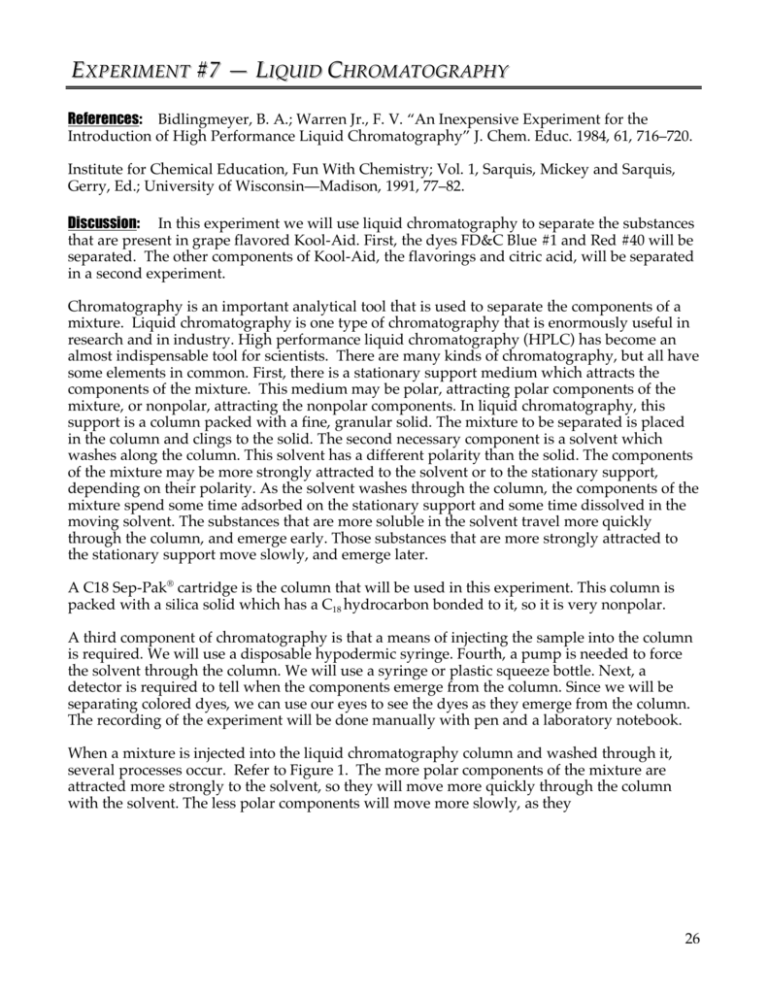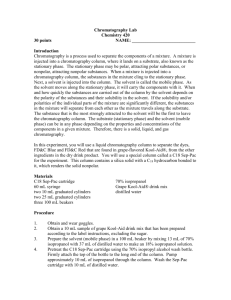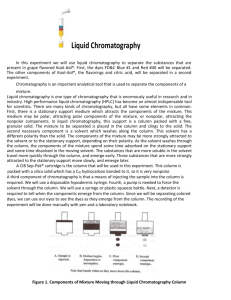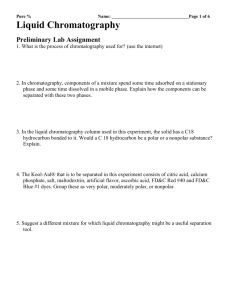Expt07-Liquid Chromatography
advertisement

E EXXPPEERRIIM MEEN NTT # #77 — — LLIIQQUUIIDD C CHHRROOM MA ATTO OG GR RA APPH HY Y References: Bidlingmeyer, B. A.; Warren Jr., F. V. “An Inexpensive Experiment for the Introduction of High Performance Liquid Chromatography” J. Chem. Educ. 1984, 61, 716–720. Institute for Chemical Education, Fun With Chemistry; Vol. 1, Sarquis, Mickey and Sarquis, Gerry, Ed.; University of Wisconsin—Madison, 1991, 77–82. Discussion: In this experiment we will use liquid chromatography to separate the substances that are present in grape flavored Kool-Aid. First, the dyes FD&C Blue #1 and Red #40 will be separated. The other components of Kool-Aid, the flavorings and citric acid, will be separated in a second experiment. Chromatography is an important analytical tool that is used to separate the components of a mixture. Liquid chromatography is one type of chromatography that is enormously useful in research and in industry. High performance liquid chromatography (HPLC) has become an almost indispensable tool for scientists. There are many kinds of chromatography, but all have some elements in common. First, there is a stationary support medium which attracts the components of the mixture. This medium may be polar, attracting polar components of the mixture, or nonpolar, attracting the nonpolar components. In liquid chromatography, this support is a column packed with a fine, granular solid. The mixture to be separated is placed in the column and clings to the solid. The second necessary component is a solvent which washes along the column. This solvent has a different polarity than the solid. The components of the mixture may be more strongly attracted to the solvent or to the stationary support, depending on their polarity. As the solvent washes through the column, the components of the mixture spend some time adsorbed on the stationary support and some time dissolved in the moving solvent. The substances that are more soluble in the solvent travel more quickly through the column, and emerge early. Those substances that are more strongly attracted to the stationary support move slowly, and emerge later. A C18 Sep-Pak® cartridge is the column that will be used in this experiment. This column is packed with a silica solid which has a C18 hydrocarbon bonded to it, so it is very nonpolar. A third component of chromatography is that a means of injecting the sample into the column is required. We will use a disposable hypodermic syringe. Fourth, a pump is needed to force the solvent through the column. We will use a syringe or plastic squeeze bottle. Next, a detector is required to tell when the components emerge from the column. Since we will be separating colored dyes, we can use our eyes to see the dyes as they emerge from the column. The recording of the experiment will be done manually with pen and a laboratory notebook. When a mixture is injected into the liquid chromatography column and washed through it, several processes occur. Refer to Figure 1. The more polar components of the mixture are attracted more strongly to the solvent, so they will move more quickly through the column with the solvent. The less polar components will move more slowly, as they 26 spend more time adsorbed to the column medium. Ideally, the components should emerge at different times. A measure of the degree of separation that is achieved is called the resolution of the system. A second process that occurs which works against resolution is that as the band of each component moves down the column, the band widens due to diffusion. As bands widen they overlap each other more easily and prevent clean separation or resolution of the components. Materials: Isopropanol, C3H7OH, 70% or 91%, colorless, unscented Grape Kool-Aid® or other grape drink, unsweetened Sep-Pak® C18 cartridge Graduated cylinders, 10-mL and 25-mL Beakers, 4, 50-mL or 10-mL Beakers, 4, 100-mL Syringe, 1 mL or 2 mL with male Luer® tip Syringe, 10-mL with male Luer® tip, or 50-mL or 100-mL dropper bottles with plastic tips, or l00-mL or 250-mL wash bottles Procedure: NOTE: Isopropyl alcohol is flammable. Keep it away from flames. Part I — Isocratic Separation In an isocratic separation, the solvent composition and flow rate are held constant throughout the experiment. The solvent composition is chosen to be able to elute both of the dyes in the grape drink at different rates. In an isocratic separation, the resolution, selectivity and efficiency of the separation can be calculated. 1. PREPARE KOOL-AID. Prepare the grape Kool-Aid as directed on the package, but omit the sugar. To prepare less than a whole package, use 0.5 g/250 mL water. 27 2. PREPARE THE ISOPROPANOL ELUANT. Prepare 18% (v/v) isopropanol in water to be used as the mobile phase. Combine 13 mL of 70% isopropanol with 37 mL distilled water (or 10 mL 91% isopropanol with 40 mL distilled water). 3. PRETREAT THE C18 SEP-PAK® CARTRIDGE. To help eliminate remixing of closely eluting bands in the cartridge, cut off the exit tube of the cartridge (the shorter end) at the point where it meets the body of the cartridge. Pre-wet the cartridge by pumping about 10 mL of undiluted (70% isopropanol) through the cartridge. If you are using a syringe, fill it with 10 mL of the undiluted isopropanol. Attach the tip to the long end of the Sep-Pak® cartridge, and pump the isopropanol through the syringe at a rate of 5–10 mL per minute. Collect the eluted alcohol in a 10 mL graduated cylinder to monitor the flow rate. If you are using a plastic bottle with a pointed dropper top or a wash bottle, attach the top of the filled bottle firmly to the cartridge, and slowly pump the isopropanol through the cartridge. Next, wash the cartridge with 10 mL of distilled water at the same flow rate. 4. INJECT THE SAMPLE. Use a small (1- or 2-mL) syringe to slowly inject 1 mL of the Kool-Aid sample onto the column. Discard the column effluent (the portion that washed out as you injected the sample). 5. ELUTE THE SAMPLE. Use a 10-mL syringe or a plastic dropper bottle to slowly elute the dyes. Fill the syringe or dropper bottle with the 18% isopropanol eluant, and pump at a steady rate of 5–10 mL per minute. Collect the column effluent in a 10-mL graduated cylinder. Record the volume of effluent collected as the first and last of the colored drops of each of the dyes emerge. If there is not a perfect separation between the blue- and red-colored bands, record data for the beginning and end of the intermediate purple band. The center of the purple band will serve as the end of the first band and beginning of the last. 6. REGENERATE THE CARTRIDGE AND REPEAT THE MEASUREMENTS. Repeat the measurements two more times. Show all your data, and use the average values to make the calculations that are described below. Between injections, wash the column with 10 mL of distilled water at the same flow rate of 5–10 mL per minute. If colored material builds up on the column, repeat the pretreatment procedure. 28 7. CALCULATE THE RESOLUTION, SELECTIVITY, AND EFFICIENCY. Determine the following values. Show how each calculation is carried out and record your data in a table like the one shown below. The shaded sections do not need to be filled in. 1. VR is retention volume. The retention volumes for the dyes in the experiment are the volumes corresponding to the centers of the red and blue bands. 2. W is the band width, or the volume in mL of each dye as it emerges from the column. 3. VRavg is the total volume eluted at the center of the band of each of the dyes. 4. L is the column length. The cartridges in this experiment are 1.25 cm long. 5. The column radius is r. These cartridges have a radius of 0.5 cm. 6. VM is mobile phase volume. This represents about 50% of the total empty column volume and can be estimated as VM = 0.5 π r2 L. The value of VM will be in cm3 (mL) if r and L are measured in centimeters. 7. k’ is the capacity factor. This is a unitless measure of the retention for each of the dyes, and can be calculated as k’ = (VRavg – VM) / VM. The optimum range for k’ is between 1 and 10. 8. α is the selectivity or separation factor. It is the ratio of the separation of the k’ values: α = k’2/k’1 where k’2 is the larger k’ value. For example, a value for a of 1.1 indicates that the column shows a 10% greater rententivity for the component that elutes second. Generally, a mobile phase is chosen which gives a value for α between 2 and 10. 9. N represents the number of theoretical plates in the column. This can be considered as the number of times a solute is exchanged back and forth between the stationary and the mobile phase. The calculation is based on the dye that is eluted last. Generally, columns with a larger value for N are more efficient. In the small cartridges used, N should have a value between 20 and 200. 10. R is the resolution. This represents the major goal of the experiment, the measure of how well the two components are separated by the column. R = (VR1 — VR2) / 0.5(W1 + W2). The numerator is the volume between bands. This is related to the selectivity. The denominator represents the average bandwidth, which is proportional to the efficiency of the column. As resolution increases above a value of 1, there is much greater total separation of the dyes. 29 Part 2 — Step Gradient Separation In this type of procedure, the composition of the eluting liquid is changed. Since the column is nonpolar, first a very polar solvent, water, will be used. Then its composition will be changed to less polar by adding more isopropanol. With this procedure we will be able to separate the citric acid and flavoring oils as well as the dyes. 1. PREPARE THE ISOPROPANOL ELUANTS. Prepare the following concentrations of isopropanol in water by mixing the suggested amounts: 5% isopropanol in water: Mix 3.5 mL 70% isopropanol and 46.5 mL distilled water (or 2.8 mL 91% isopropanol and 47.2 mL distilled water). 28% isopropanol in water: Mix 20.0 mL 70% isopropanol and 30.0 mL distilled water (or 15.5 mL 91% isopropanol and 34.5 mL distilled water). 2. PRETREAT THE CARTRIDGE. Follow the same procedure as in step 3. 3. INJECT THE SAMPLE AND ELUTE THE COMPONENTS. Inject 1 mL of the grape drink. Elute the polar components of the mixture (citric acid and any sugar present) by passing 5 mL of water through the column. Collect the effluent in a small beaker. Next, elute the red dye by passing 5 to 10 mL of 6% isopropanol through the column. Note that large amounts of the 6% isopropanol can be used without eluting the blue dye. Collect this effluent in a second beaker. Thirdly, use the 28% isopropanol to elute the blue dye. Collect it in a third beaker. Lastly, use 8 mL of 70% isopropanol to elute the polar flavor oils and other nonpolar additives. Collect this fraction in a fourth beaker. 4. EVAPORATE THE SOLVENTS AND EXAMINE THE COMPONENTS. Allow the four beakers of solution to evaporate by leaving them in the fume hood until the next laboratory period. Observe and describe the contents of each of the beakers. Questions: 1. What is meant by polarity of molecules? What causes differences in polarity? 2. In discussing solubility, the rule “like dissolves like” is frequently used. What does this mean? 3. Draw the structural formula of isopropanol. Explain how it differs in polarity from water. 4. For good separation of the dyes, the resolution should be greater than one. What was the value you calculated? Did the two dyes overlap as they emerged from the column, or was the separation a good one? 5. In the step gradient separation, four separate fractions were collected. How were these related to the polarities of the column and of the eluting solvent? 30 Experiment #7 DATA SHEET—Liquid Chromatography Red Dye Blue Dye Experimental System VR (start) VR (end) W = VR (end) – VR (start) Vravg = VR (start) + 0.5 W L r VM = = 0.5 π r2 L k’ = (VRavg – VM) / VM α = k’2/k’1 N = 16 (VR/W)2 R = (VR1 — VR2) / 0.5(W1 + W2) 31





